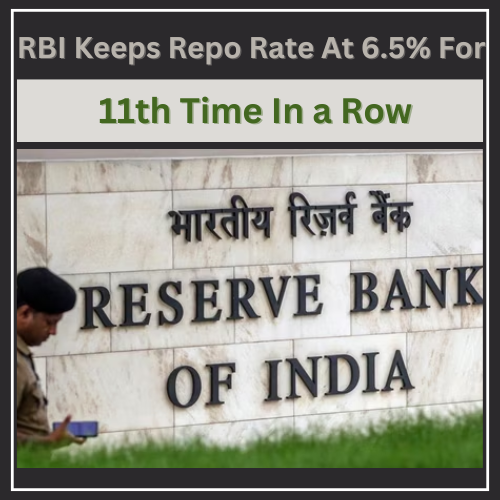Introduction
Hello, fabulous readers! Let’s talk about the big financial buzz that everyone’s chatting about. Yes, the Reserve Bank of India (RBI) has once again kept the repo rate steady at 6.5%. It’s the eleventh time in a row! Wondering what that means for you and the economy? Let’s dive in together—because, honestly, finance can be fun and easy to understand when we break it down!

What’s the Repo Rate and Why Does It Matter?
Before we jump into the nitty-gritty, let’s clear up what this “repo rate” actually is. Picture this: banks sometimes need money to manage their operations, and they borrow it from the RBI. The interest rate the RBI charges them? That’s the repo rate! It’s like a borrowing cost for banks, which then affects the interest rates we all deal with—home loans, car loans, you name it.
Now, keeping the rate at 6.5% means the RBI is holding steady for a while. This consistency can provide stability in borrowing costs. For us, that’s a sigh of relief—no surprise hikes in EMIs for now! Yay for predictability, right?
Why RBI Decided to Keep Calm and Hold Steady
The RBI’s Monetary Policy Committee (MPC) huddled up and decided that this is not the time to shake things up. Inflation is always lurking in the background, and while it’s been somewhat under control lately, the central bank is playing it safe. They’re essentially saying, “Let’s wait and watch before making any drastic moves.”
Also, remember, earlier rate hikes have already slowed down inflation. By staying at 6.5%, the RBI is giving those past actions time to work their magic. It’s like baking cookies—you’ve already set the oven temperature; now you wait for them to turn golden brown.
What This Means for Us and the Economy
Here’s the big question: how does this affect you, me, and everyone else? For starters, borrowers can breathe a bit easier. Home loan EMIs won’t shoot up (for now), which is music to the ears of anyone with big financial commitments. Businesses also benefit, as stable rates mean they can plan investments without worrying about sudden cost increases.
On the flip side, depositors may feel a teensy bit disappointed. Fixed deposit rates might not climb higher anytime soon, so those looking for better returns on their savings will have to explore other options. But hey, that’s all part of the balance the RBI is trying to strike—supporting growth while keeping inflation in check.
The Inflation and Growth Story: Balancing Act, Much?
Speaking of inflation, it’s a tricky little thing. After all, no one likes their grocery bills going up, right? The RBI is laser-focused on keeping inflation within its target range (4%, give or take). Recent data shows that inflation has been cooling off, but it’s not time to celebrate just yet. One unexpected spike in global oil prices or food costs could throw a wrench in the works.
At the same time, India’s economy is showing promise. The GDP growth forecast remains upbeat, with plenty of room for optimism. The repo rate pause is like giving the economy a chance to grow without being weighed down by higher borrowing costs. It’s all about walking that fine line between controlling inflation and fostering growth.
How Does This Compare Globally?
Now, let’s zoom out and see how we’re doing compared to the rest of the world. While the RBI is holding steady, central banks like the US Federal Reserve and the European Central Bank have been juggling rate hikes and pauses, depending on their inflation battles.
Globally, inflation has been a mixed bag—some countries are seeing relief, while others are still grappling with higher prices. The RBI’s cautious stance puts India in a good spot, aligning us with nations that are playing the long game for economic stability.
Market Reactions: What Are People Saying?
Markets, as always, have plenty to say! Stocks saw minor fluctuations, with financial sectors breathing a sigh of relief. Bond markets, too, took the news in stride, signaling approval of the RBI’s steady approach. Economists are mostly on board, with many praising the focus on stability.
Meanwhile, social media is buzzing with chatter. Some are thrilled about no EMI hikes, while others are debating whether the RBI should’ve taken a bolder approach. Either way, it’s clear that everyone’s paying attention, and that’s a win for financial literacy!
Looking Ahead: What’s Next?
So, what’s on the horizon? The RBI is likely to keep a close eye on inflation trends, global economic shifts, and domestic growth. The next MPC meeting could bring surprises, but for now, it’s all about cautious optimism.
For us, this means staying mindful of our financial goals. Whether it’s planning a big purchase or tweaking your savings strategy, this steady repo rate gives you some breathing room. So, let’s make the most of it!
Wrapping It Up
The RBI’s decision to keep the repo rate at 6.5% is a steady move in a world of constant change. It’s about giving the economy the time it needs to adjust while keeping inflation in check. For borrowers, it’s good news; for savers, maybe not so much—but hey, balance is the name of the game.
Here’s to keeping an eye on the numbers while living our best lives! Whether you’re a finance newbie or a seasoned pro, understanding these decisions empowers you to take charge of your money. Let’s keep the conversation going—what do you think about the RBI’s latest move? Drop your thoughts below! 🌟
